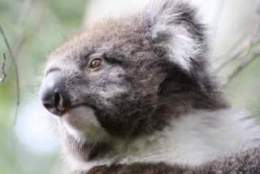30 April 2014
 Results from South Australia’s Great Koala Count have been published with researchers giving “citizens’ science” the thumbs up for helping determine koala distribution and abundance through the State’s first koala database.
Results from South Australia’s Great Koala Count have been published with researchers giving “citizens’ science” the thumbs up for helping determine koala distribution and abundance through the State’s first koala database.
Published in the journal Ecology and Evolution, the University of Adelaide, University of South Australia and CSIRO researchers used data solely collected in the Great Koala Count to produce a distribution model of South Australia’s koalas.
The Great Koala Count took place on Wednesday 28 November 2012 with volunteer “citizen scientists” searching for koalas between 6 am and 8 pm and reporting sightings, absences and general activity. The count was done by UniSA, CSIRO and ABC Local Radio, and the data was modelled by University of Adelaide ecologists.
“Our model provides a good prediction of current and potential distribution of koalas in SA, plus a preliminary population size estimate for the Mount Lofty Ranges,” says the University of Adelaide’s Professor Corey Bradshaw, Director of Ecological Modelling in the University’s Environment Institute. His former PhD student, Dr Ana Sequeira, led the data analysis and writing.
“Although we’ve learned a few things that will help us refine the science of future surveys, this project enabled the collection of unique data that would have been difficult or impossible to gather otherwise,” says Professor Bradshaw.
The model showed that temperature range, elevation and rainfall were the best predictors of koala occurrence, with most suitable habitats in Kangaroo Island, the Mount Lofty Ranges and the tips of SA’s three peninsulas. The population estimate of koalas in the Mount Lofty Ranges was 114,000, with a 95% confidence range of 28,000 to 200,000.
 UniSA’s Professor of Urban Ecology, Professor Chris Daniels, says koalas had been hunted to extinction in SA’s south-east in the 1900s but numbers increased with the establishment of populations on Kangaroo Island, where they became overabundant, and with reintroduction to the mainland in the 1950s and 1960s. They are classed as vulnerable to extinction in eastern Australia.
UniSA’s Professor of Urban Ecology, Professor Chris Daniels, says koalas had been hunted to extinction in SA’s south-east in the 1900s but numbers increased with the establishment of populations on Kangaroo Island, where they became overabundant, and with reintroduction to the mainland in the 1950s and 1960s. They are classed as vulnerable to extinction in eastern Australia.
“Since the reintroduction, we haven’t known how many koalas there are or their range, although with natural habitat under threat from urban development, we’ve seen them become an increasingly suburban animal,” says Professor Daniels.
“The Great Koala Count and this modelling have given us valuable information we can use to monitor the health and changing distribution of this well-known and loved Australian marsupial.”
The Great Koala Count used a smartphone app that allowed volunteers to take a photograph of koalas they found with automatically generated location data. Other collaborators in the project were the Department of Environment Water and Natural Resources (DEWNR) and the Adelaide and Mount Lofty Natural Resource Management Board.
Media contact: Kelly Stone phone (08) 8302 0963 mobile 0417 861 832




